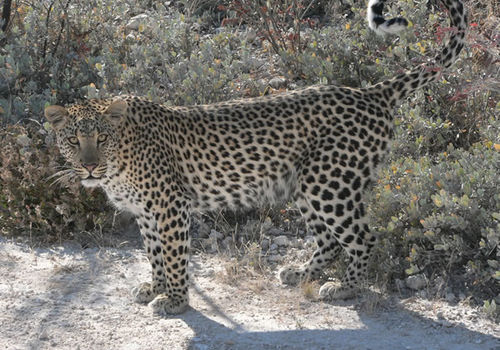
Leopard
Panthera pardusLeopard
Introduction: Leopards (Panthera pardus) are solitary animals, except during the mating season or when females are accompanied by juveniles. They are primarily nocturnal creatures but have been seen in the daytime, particularly in national parks and in remote area. As they are very secretive animals, making contact is difficult. Approaching luxury tented campsites they can be recognised by their repeated hoarse rasping cough.
In the early morning they habitually lie in the sun on vantage points such as rocks and rocky ridges, giving them a wide view of the surrounding terrain. They are also accomplished tree climbers; a trait often associated with leopard is to secure their kill on high from other predators. They hide during the rest of the day and hunt at night.
Their hunting technique entails stalking and pouncing, killing larger prey with a holding bite to the throat which suffocates larger prey. Smaller prey are killed by a bite to the back of the neck which usually severs the spinal cord. Plucking fur off the carcass follows, before feeding on the softer parts of the body. The remains of the catch and stomach contents will be covered with grass and sand.
They are agile climbers and when there is competition from other predators, the carcass will be cached out of reach in the fork of a large tree. Males defend large territories which overlap the territories of two or even threefemales who defend their territories against other females.
Although no other wild cat is spread over such a wide range or with the diverse prey base as the leopard, it is still under threat in many regions. Once common in all parts of Africa apart from the deserts of the Sahara, it has now disappeared from most parts of northern Africa, apart from a few widespread areas of the Atlas Mountains, and is scarce in the extreme west of the continent.
Distribution: There are numerous places where one can view leopard in their natural environment while travelling in Namibia. Several lodges offer conservation projects which are worth a visit. Accommodation at Okonjima Bush Camp or Okonjima Main Lodge offers the opportunity to view the work done by the Africat Foundation in Namibia.
Diet: A varied diet from mice to mammals twice their size emphasizes the adaptability of the leopard, although they generally feed on medium and small antelope, or the young of large game. The range of species eaten, depends on availability in the area which they live. They have also have been known to feed on hyrax, baboon, fox, fish, reptiles and domestic dogs. The leopard is also well-known for predations of sheep, goats and poultry.
Colouring: Leopards have black spots arranged in rosettes, contrasted on a yellow-golden background. They have single black spots on their limbs and head. Their tails are white-tipped on the underside.
Breeding: Young are born any time of the year as they are non-seasonal breeders. Leopard cubs are born after a gestation period of 3½ months and females usually give birth to 2 or 3 cubs in hidden lairs or natural holes, thick bush caves and hollow trees.
Size: Their head and body length is 2.1m including the tail, and they weigh in around 60kg. Females are around 1.8m in total length, but with a much smaller mass of some 32kg.
Klein Windhoek

